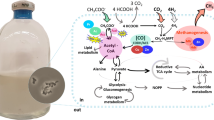Abstract
The effects of Cd, Cu, and Ni on pure cultures of thermophilic methanogenic bacteria were studied. The bacteria used wereMethanobacterium thermoautotrophicum and TAM, a thermophilic, acetate-decarboxylating, methanogenic bacterium. Much lower concentrations of heavy metals were needed to cause initial inhibition of TAM (1 mg/liter Cu and Cd; 5 mg/liter Ni) compared withM. thermoautotrophicum (10 mg/liter Cu and Cd; and 100 mg/liter Ni). No growth of TAM occurred at 5 mg/liter Cu and 25 mg/liter Ni, while the corresponding values forM. thermoautotrophicum were 50 mg/liter Cu and 200 mg/liter Ni. Cd (50 mg/liter) was totally inhibitory toM. thermoautotrophicum but allowed minimal growth of TAM. Ni stimulated both organisms at an optimal concentration of 5 mg/liter forM. thermoautotrophicum and 1 mg/liter for TAM. The toxicity of Cd and Cu was found to depend upon the presence of Ni in the medium.
Similar content being viewed by others
Literature Cited
Ahring BK, Westermann P (1983) An improved method for measuring H2−CO2 uptake during growth of methanogenic bacteria Can J Microbiol 29:1218–1220
Ahring BK, Westermann P (1983) Toxicity of heavy metals to thermophilic anaerobic digestion. Eur J Appl Microbiol Biotechnol 17:365–370
Ahring BK, Westermann P (1984) Isolation and characterization of a thermophilic, acetate-utilizing methanogenic bacterium. FEMS Microbiol Lett 25:47–52
Babich H, Stotzky G (1977) Sensitivity of various bacteria, including actinomycetes, and fungi to cadmium and the influence of pH on sensitivity. Appl Environ Microbiol 33:681–695
Babich H, Stotzky G (1980) Environmental factors that influence the toxicity of heavy metal and gaseous pollutants to microorganisms. CRC Crit Rev Microbiol 8:99–145
Balch WE, Fox GE, Magrum LJ, Woese CR, Wolfe RS (1979) Methanogens: reevaluation of a unique biological group. Microbiol Rev 43:206–296
Bryant MP (1972) Commentary on the Hungate technique for culture of anaerobic bacteria. Am J Clin Nutrit 25:1324–1328
Bryant MP (1976) The microbiology of anaerobic digestion and methanogenesis with special referance to sewage. In: Schlegel HG, Barnes J (eds) Microbial energy conversion. Göttingen: Goltze, pp 107–118
Diekert G, Weber B, Thauer RK (1980) Nickel dependence of factor F430 content inMethanobacterium thermoautotrophicum. Arch Microbiol 127:273–278
Gadd GM, Griffiths AJ (1978) Microorganisms and heavy metal toxicity. Microb Ecol 4:303–317
Graef SP, Andrews JF (1974) Stability and control of anaerobic digestion. J Water Pollut Control Fed 46:666–683
Hallas LE, Thayer JS, Cooney JJ (1982) Factors affecting the toxic effect of tin on estuarine microorganisms. Appl Environ Microbiol 44:193–197
Hobson PN, Shaw BG (1976) Inhibition of methane production byMethanobacterium formicicum. Water Res 10:849–852
Hungate RE (1950) The anaerobic mesophilic cellulolytic bacteria. Bacteriol Rev 14:1–49
Kaspar HF, Wuhrmann K (1978) Kinetic parameters and relative turnovers of some important catabolic reactions in digesting sludge. Appl Environ Microbiol 36:1–7
Kaspar HF, Wuhrmann K (1978) Product inhibition in sludge digestion. Microb Ecol 4:241–248
Krocker EJ, Schulte DD, Sparling AB, Lapp HM (1979) Anaerobic treatment process stability. J Water Pollut Control Fed 51:718–727
Kugelman IJ, Chin KK (1971) Toxicity, synergism, and antagonism in anaerobic waste treatment processes. In: Gould RF (ed) Advances in chemistry series 105. Washington DC: American Chemical Society, pp 55–90
Lawrence AW, McCarty PL (1965) The role of sulfide in preventing heavy metal toxicity in anaerobic treatment. J Water Pollut Control Fed 37:392–406
Lighthart B (1980) Effects of certain cadmium species on pure culture and litter populations of microorganisms. Antonie van Leeuwenhoek 46:161–167
McBride BC, Wolfe RS (1971) Biosynthesis of dimethylarsine byMethanobacterium. Biochemistry 10:4312–4317
McInerney MJ, Bryant MP, Hespell RB, Costerton JW (1981)Symtrophomonas wolfei gen. nov. an anaerobic syntrophic, fatty acid-oxidizing bacterium. Appl Environ Microbiol 41:1029–1039
Parkin GF, Speece RE, Yang CHJ, Kocher WM (1983) Response of methane fermentation systems to industrial toxicants. J Water Pollut Control Fed 55:44–53
Robinson JA, Tiedje JM (1982) Kinetic of hydrogen consumption by rumen fluid, anaerobic digestor sludge, and sediments. Appl Environ Microbiol 44:1374–1384
Thauer RK (1982) Nickel tetrapyrroles in methanogenic bacteria: structure, function and biosynthesis. Zentralbl Bakteriol C 3:265–270
Walker CW, Houston CW (1981) Toxicity of cadmium to bacteria. Biotechnol Lett 3:437–442
Whitman WB, Wolfe RS (1980) Presence of nickel in factor F fromMethanobacterium bryantii. Biochem Biophys Res Commun 92:1196–1201
Zinder SH, Anguish T, Cardwell SC (1984) Selective inhibition by 2-bromomethanesulfonate of methanogenesis from acetate in a thermophilic anaerobic digestor. Appl Environ Microbiol 47:1343–1345
Zinder SH, Cardwell SC, Anguish T, Lee M, Koch M (1984) Methanogenesis in a thermophilic (58°C) anaerobic digestor:Methanothrix sp. as an important aceticlastic methanogen. Appl Environ Microbiol 47:796–807
Author information
Authors and Affiliations
Rights and permissions
About this article
Cite this article
Ahring, B.K., Westermann, P. Sensitivity of thermophilic methanogenic bacteria to heavy metals. Current Microbiology 12, 273–276 (1985). https://doi.org/10.1007/BF01567977
Issue Date:
DOI: https://doi.org/10.1007/BF01567977




